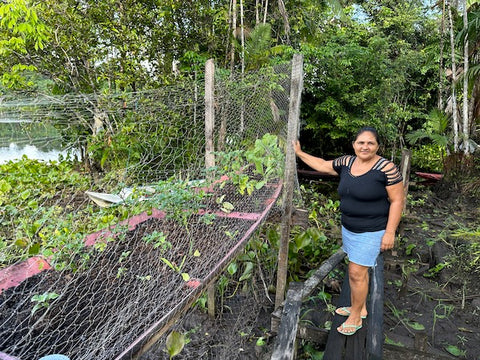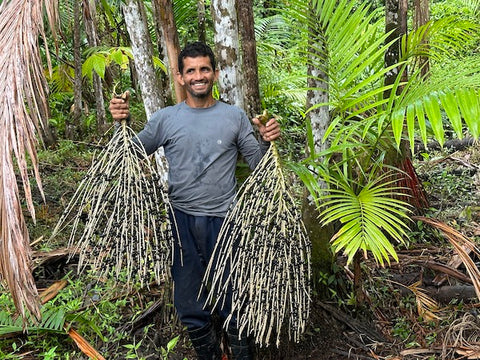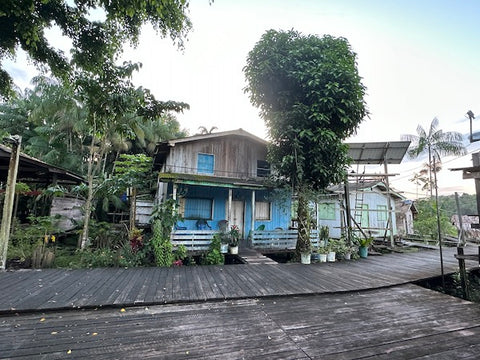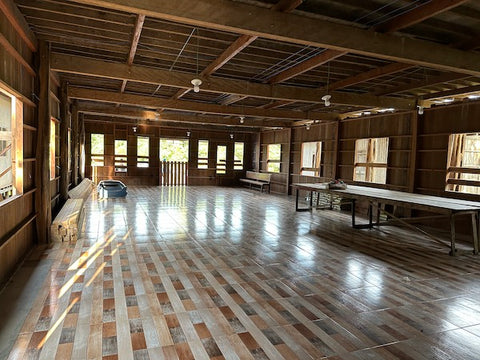In the heart of the Amazon rainforest, where lush greenery and vibrant biodiversity come together, there is much to learn about a different way of life. Meet the SAMBAZON Açaí harvesters, individuals whose lives are intricately woven into the fabric of our triple bottom line business. These dedicated individuals play a crucial role in preserving the balance of the Amazon ecosystem while contributing to the global spread of the Açaí berry.
5 Interesting Facts about SAMBAZON Açaí Harvesters' Lives

1. Their Knowledge of the Amazon Rainforest’s Ecology
SAMBAZON Açaí harvesters are stewards of the environment in the Amazon Rainforest. The Açaí palm, native to the region, grows naturally in the rainforest's understory. Harvesters use traditional and sustainable methods to maintain the fruit, ensuring that the delicate balance of the ecosystem remains intact.
As summarized in The Amazonian Caboclo and the Açaí Palm: Forest Farmers in the Global Market, Eduardo S. Bondízio explains that “knowledge about the ecology of palms and floodplains learned through experimentation and cultural diffusion has been the farmers’ best technology.” For these harvesters, Açaí is more than just a commodity; it's deeply intertwined with their cultural heritage. The Açaí berry has been a staple in the diet of indigenous communities for centuries, providing not only sustenance but also a source of income. SAMBAZON works closely with local communities that have preserved and nurtured these trees for generations.

2. Finding Other Purposes for the Palm
Within the Amazon Rainforest, there are plenty of resources that harvesters utilize beyond the Açaí tree. For SAMBAZON Açaí harvesters, the forest plays a vital role in their daily existence. As Brondízio explains, local harvesters in the Amazon recognize and use “21 palm species in a diversity of more than 200 types of uses and applications,” such as forest fruits to eat during the rainy season, and “common raw materials like fibers and stems used to build homes and fish traps.”
For harvesters with agroforestry knowledge, the forest can provide nourishing food, medicine, and a source of independence from the markets for raw materials. It’s an important part of their productivity, a way to sustain their households, and creating economic opportunities that ripple through the market.

3. The Houses & Communities Harvesters Live In
Nestled along the rivers of the Amazon Rainforest, the houses of SAMBAZON açaí harvesters are perched on stilts to protect against the daily tides that can reach impressive heights of 2-4 meters. The elevation provides air circulation, and the location provides access to both water and fishing.
Surrounding most dwellings is a house garden, that includes native and exotic species such as bananas, guavas, cacao, lime, and coconuts. These gardens provide seasoning, medicine, food, and beautiful blooming flowers. According to Brondízio, "houses can be built entirely with local plant resources... houses built with plant parts maintain a comfortable temperature inside," which is important in the heat of the Brazilian Amazon.

4. Fish for Food and Boats for Transportation
Flowing through the Amazon estuary are rivers that pulse with life. "Fish is the main protein source for many rural and urban communities in the region," Brondízio explains. Locals have a deep understanding of fish ecology based on the environment, tides, and diversity of rivers.
Canoes are used to fish, called montarias or cascos, and are crafted from hard wood and measure 2-4 meters. Montarias, larger in size and adorned with vibrant colors, proudly display the names of fishers, their lovers, their hopes and dreams. While Montarias use small motors or sails, the cascos, petite and made from a single trunk, rely on paddlers to move through the water.

5. Harvester’s Livelihood and SAMBAZON’s Global Impact
SAMBAZON is committed to Fair Trade principles, ensuring that a fair share of profits goes back to the communities involved in Açaí harvesting. By not only supporting the livelihoods of the harvesters, but also funding community development projects, ranging from education to healthcare, SAMBAZON is able to invest in positive change. You can read more about our latest Fair Trade Project here.
SAMBAZON's Açaí products have reached far beyond the Amazon rainforest, becoming a global phenomenon. By choosing SAMBAZON, consumers contribute to a sustainable supply chain and support the livelihoods of Açaí harvesters who follow Certified Fair Trade and Organic guidelines.
As we indulge in the Delicious Powers of Açaí, it's essential to recognize the harvesters who make it possible for this Açaí Berry to extend its reach far beyond the Amazon Rainforest. SAMBAZON Açaí harvesters showcase the importance of preserving the biodiversity of the Amazon rainforest through their practices and their lifestyle, setting an inspiring example for the future of responsible food production. So, the next time you savor a purple smile, remember the hands that carefully harvested it, and choose to support triple bottom line businesses that give back to those communities.
Source
Brondízio, Eduardo S. (2008). The Amazonian Caboclo and the Açaí Palm: Forest Farmers in the Global Market. The New York Botanical Garden Press.

